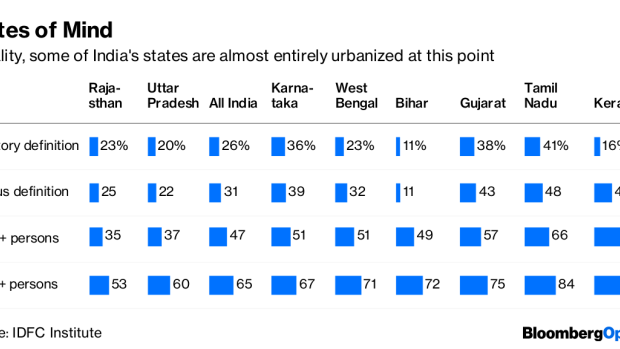Jan 11, 2019
India’s a Land of Cities, Not Villages
, Bloomberg News

(Bloomberg Opinion) -- It’s an election year in India, with the world’s largest polls expected in the spring. The focus of politicians is, as usual, on farmers and rural areas and competitive pandering to both — hardly surprising in a country that considers itself a nation of villages.
However, this narrative has one major flaw. India is, in fact, more urban than politicians know or acknowledge. This seriously affects India’s growth prospects, leading to inefficiencies and loss of productivity in both rural and urban areas. What’s worse, the resulting misallocation of resources is making India’s blossoming urban areas well-nigh unlivable.
The problem — in India as elsewhere — is largely one of definition. What constitutes a city or urban area varies widely around the world. Some nations employ simple population cutoffs: Mexico and Venezuela count any town with more than 2,500 residents as urban, while New Zealand uses 1,000 people. Since 2000, the U.S. Census has focused instead on population density (above a minimum threshold of 2,500 residents). China uses a density criterion of 1,500 people per square kilometer, but recently expanded the definition to include residents of villages that are directly connected to municipal infrastructure or that receive public services from urban municipalities.
In India, only “statutory towns” are considered urban and have a municipal administration — a definition that officially leaves the country 26 percent urban. State governments make the decision using widely differing criteria; demographic considerations are peripheral at times. The Census of India provides the only other official, and uniform, estimate. Its formula uses a mix of population, density and occupation criteria, and pegs India at 31 percent urban.
Such estimates can be misleadingly low. For instance, Kerala is statutorily only 16 percent urban. Yet the census sees the well-developed southern state as approximately 48 percent urban. If we use a population cutoff of 5,000 residents as Ghana and Lebanon do, or even Mexico’s threshold of 2,500 people, Kerala’s urban share leaps to 99 percent, which is more consistent with ground reality. In effect, then, a state that’s close to 100 percent urban is being governed as if it was only 16 percent urban.
This pattern plays out across many large Indian states. Using a reasonably conservative definition as Ghana does, in fact, India is already close to 50 percent urban, far removed from the dominant narrative that India lives in her villages.
The consequences of underestimating the urban share of the population are dire. Resources are badly misallocated: By one estimate, over 80 percent of federal government financing still goes to rural development. This reduces incentives for politicians, especially rural ones, to change the status quo. Tens of millions of Indians who live in dense, urban-like settlements are governed by rural governments that lack the mandate and the money to deliver basic services. In India, urban governments are constitutionally required to provide things such as fire departments, sewer lines, arterial roads and building codes. Local bodies in rural areas aren’t.
Not acknowledging towns as urban also encourages haphazard and chaotic development. As satellite data clearly show, most cities extend well beyond their administrative limits, and dense, linear settlements spread out of those cities along transit corridors. This growth is unregulated and unplanned, marred by narrow roads, growing distance from major thoroughfares, limited open space and haphazardly divided plots.
As the map below of growth in Kozhikode (formerly known as Calicut) between 1975 to 2014 shows, what appears to be a single economic unit is now governed by a multitude of rural and urban jurisdictions, with no mechanism to coordinate on mobility, public goods or municipal services. It’s difficult and expensive to retrofit such cities with proper infrastructure and services: In the areas below, road widths fall from an average of 10 meters pre-1990 to four meters in new growth areas.
India’s hardly the only country to face these problems, even though its size and level of development makes the challenge here particularly acute. The planet is over 50 percent urban and continues to urbanize rapidly, almost entirely in the developing regions of Asia and Africa.
As long as there are no standard definitions, urban-rural classifications are likely to be political, path-dependent and arbitrary. This will deny many countries the vital scale and agglomeration economies provided by urban areas, a necessary condition for escaping poverty.
A universal definition would need to be flexible. Instead of imposing a simple population cutoff, governments could track population densities and offer more urban services where they are highest. Additionally, satellite data can be used to track the spread of development, so that city boundaries are expanded when necessary and where logical.
Any attempt to create a common and well-understood urban definition will be politically fraught and contested. But such an effort is critical. Whether millions get to live in the equivalents of Melbourne, Tokyo or Stockholm rather than Mumbai, Lagos or Kinshasa crucially depends on these choices.
To contact the authors of this story: Reuben Abraham at reuben.abraham@idfcinstitute.orgPritika Hingorani at pritika.hingorani@idfcinstitute.org
To contact the editor responsible for this story: Nisid Hajari at nhajari@bloomberg.net
This column does not necessarily reflect the opinion of the editorial board or Bloomberg LP and its owners.
Reuben Abraham is CEO and Senior Fellow at the IDFC Institute.
Pritika Hingorani is Director and Research Fellow at the IDFC Institute.
©2019 Bloomberg L.P.





